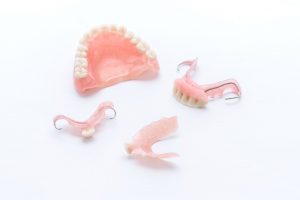
Are you tired of looking in the mirror and seeing a bunch of gaps in your smile? Then it’s time to consider your tooth replacement options. Both dental bridges and partial dentures effectively replace missing teeth, but how do you know which one is best for you? Learn about the differences between partial dentures and dental bridges to find out!
What Are Partial Dentures?
Partial dentures are a dental prosthesis designed to fill in gaps left by multiple missing teeth. Also known as partials, they are usually made from a combination of gum-colored plastic and metal or plastic only. Partial dentures clasp onto nearby natural teeth to stay in place in the mouth.
What Are the Benefits of Partial Dentures?
Partial dentures offer a range of benefits, including:
- Removable – Partial dentures are easily removable for cleaning or if you wish to sleep without them at night.
- Natural Appearance – They are also custom-designed to match both the color of your gums and remaining natural teeth.
- Budget-Friendly – Partials are one of the most affordable options to replace missing teeth.
- Prevent Bite Problems – By filling the gaps left by missing teeth, partial dentures can help prevent bite problems from developing.
What Is a Bridge?
A fixed dental bridge is an effective way to replace one to three consecutive missing teeth and restore dental function and appearance. This common dental prosthesis is made up of a false tooth (called a pontic) and two abutment crowns. The two abutment crowns are placed on top of the two healthy teeth on either side of a dental gap. Once in place, the pontic, which rests between the abutment crowns, fills the space left by a missing tooth or teeth.
What Are the Benefits of Dental Bridges?
Dental bridges share many of the same benefits as partial dentures. For example, both bridges and partials prevent dental drift by filling the gap left by one or several missing teeth. In addition, bridges are also custom-made so that they blend in extremely well with your natural smile.
However, unlike partials, most traditional bridges are not removable. Instead, they are permanently fixed to your teeth for an average period of 5 to 15 years.
Which Option Is Right for Me?
Determining which tooth replacement option is right for you will depend on several factors, including the number of teeth are you missing. If you have only lost a couple of teeth, your dentist may recommend a bridge. However, if you are missing several teeth from different parts of your dental arch, a partial denture may be more appropriate. Your future dental health, including whether you are at risk of losing even more teeth, will also influence which restoration is right for you.
Ultimately, any decision to replace missing teeth should be made in consultation with your dentist in Kansas City. Now that you know some of the key differences between partial dentures and dental bridges, you will be able to ask your dentist better questions and feel confident that you will make the right choice.
About the Author
Dr. Michael Byars has been helping Kansas City residents restore their smiles for nearly 15 years. The proud University of Missouri alumnus offers bridges, full and partial dentures, and dental implants at his conveniently located private practice. For more information about how to replace missing teeth, visit Dr. Byars’ website or call 816-781-8222.

